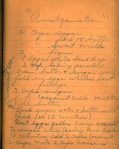First published in the Calhoun County Journal Dec. 20, 1984, this memoir of my father, Jesse L. Yancy, Jr., was written fourteen years after his death by his friend and political partner, Sellers Gale Denley. Jess Jr. was a remarkable man in a difficult time, colorful, vibrant, and generous, his life a vision of community, unity, and compassion.
If there was ever a man who loved Christmas, it was the late Sen. Jesse Yancy of Bruce. The word “loved” is used advisedly. For there are those who might be said to “enjoy” Christmas, “respect” Christmas, “anticipate” Christmas, etc., but Jesse loved Christmas. His enthusiasm might have been regarded as extreme; except that was the way Jesse was about most things. He worked hard. Then he played hard. More than likely this approach to life was a primary cause of his untimely death on Aug. 26, 1970, at the age of 44, from a massive heart attack. Prior to assuming the senate post he served as district attorney of the third circuit court district for eight years and was city attorney in Bruce for 17 years. So it wasn’t unusual that the new city library was named in his honor.
And the way that Jesse launched the Christmas season was not particularly unique or unusual, either. It began with a big party with his friends at the Bruce community building. Funds were solicited for a live band and a case or so of assorted spirits and goodies, with a few dollars left over for another project. You see, Jesse had a secret Christmas vice. He liked to dress up in a funny red suit, hide his face behind a mask of white whiskers and, on Christmas Eve, visit the area in South Bruce where most black citizens lived.
Before each of these visits his automobile was filled with candy, nuts, fruit, toys and firecrackers. In the early 1960s it was all the Christmas some of the children had. The ritual started in the ’50s when he dressed up to play Santa for his own children. His family decided he should also go see the children of the black woman who worked for them. His appearance was an immediate hit. It was the Christmas of 1960, when I started helping him with the project, that he said he realized back then on his first trip that most of the black children had never really seen Santa Claus. So it became an annual event, growing in scope each year, to make the Christmas Eve appearance. The addition of toys and other goodies was a part of the evolution. The project was financed with any excess funds from the party, plus contributions from several of us who usually helped, with Jesse taking up the slack. It started each year with several trips to area wholesalers to purchase the large volume of goodies needed for some 250 to 350 children.
The bounty would be hauled in and the Yancy children—Cindy, Tom and Lee, often assisted by cousins Bill and Bob Cooper—and others would assemble individual sacks. Then, on Christmas Eve, Jesse would put on his Santa suit, we would load up a vehicle or two—the most memorable and utilitarian being a dark green Mustang convertible— and begin the appointed rounds. There must have been a lookout, for as soon as the first vehicle crossed the railroad tracks, which marked the boundary of the black community, several young boys would take over the lead position. With wide-eyed excitement they would precede the caravan down Murphree Street shouting: “Here he comes. Here comes Santa. Here he comes.” And for the next hour or so Jesse would be in his Christmas glory.
He handed out presents to those close by while keeping an eye out for those too shy to come up to him, so he could seek them out later. He knew quite a few of them by name. And almost all of the parents knew Jesse and whispered their thanks. But if the children knew him they didn’t let on. And neither did they let on if they sometimes got a whiff of the Old Charter Santa and his helpers found useful in warding off the cold and other miseries.
The custom died with Jesse. The party lasted another year or two, and some of us talked about continuing the Santa Claus visit. But, we rationalized, it was 1970 and the children were being encouraged to visit Santa on the Square, sponsored by the city as a part of the Lion’s Club Christmas parade. So we didn’t. It has been 35 years, but every Christmas about this time I begin to get a little bit anxious. Like you feel when you know there is something you probably need to do. Like you feel when you know there is something you probably will never get to do again.
It has been suggested that one can sometimes recapture the spirit of Christmases-past by recording remembrances like these. I am confident that Jesse would overlook my indiscretion in writing about it now.











